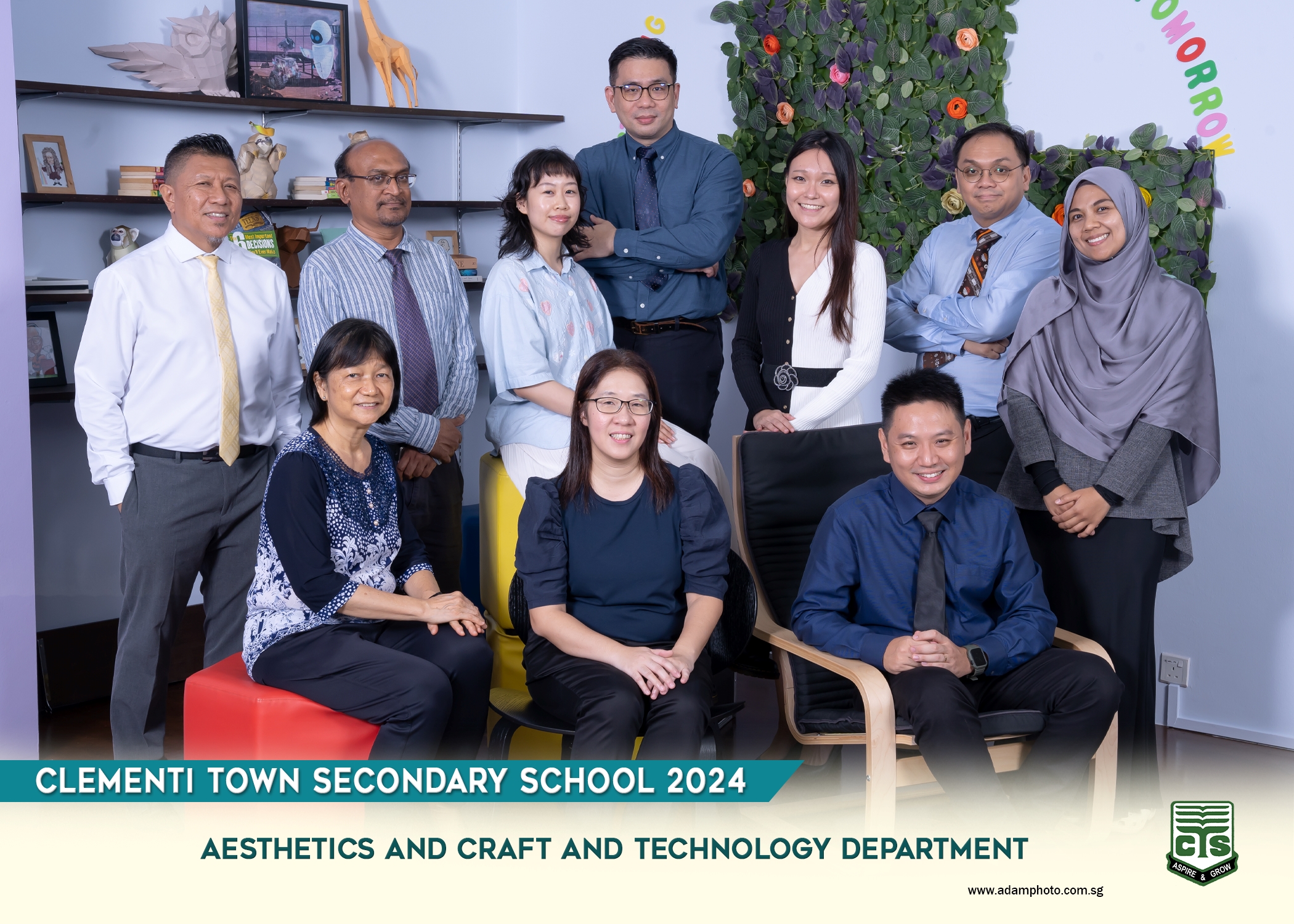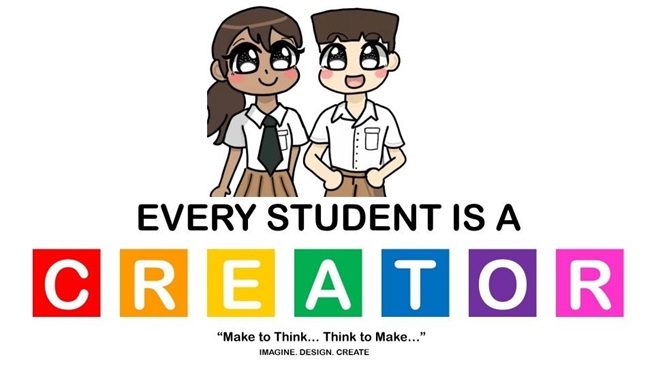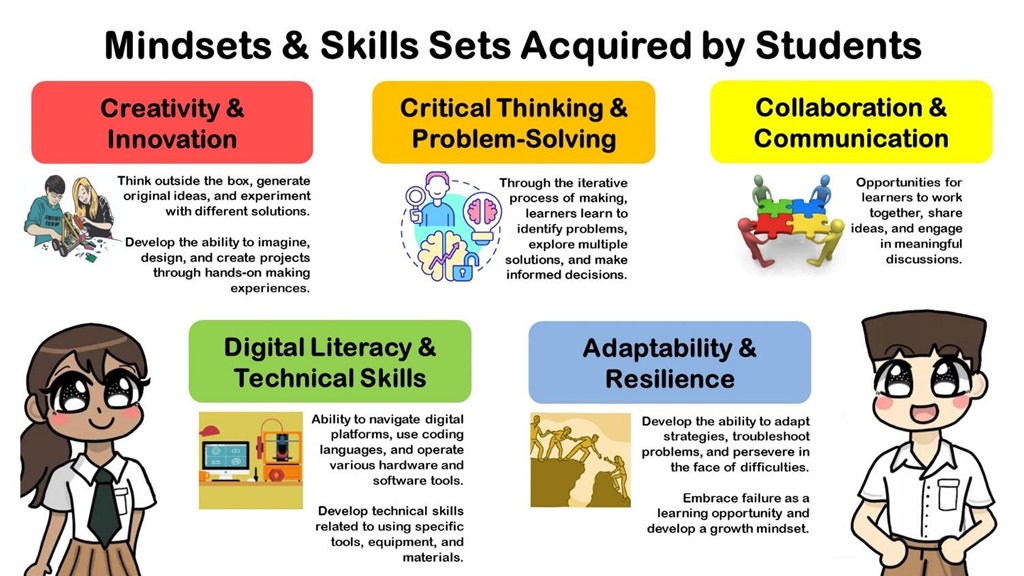Aesthetics and Craft & Technology Department

Our Teachers:
|
Head of Department |
Peh-Yeo Hwee Ching Magdalene (Mrs) |
|
SH/Aesthetics & Student Leadership (Internal) |
Lim Liangcai Jeremy (Mr) |
|
Teacher / Art |
Chan Wen Xin (Ms) |
|
Teacher / Art |
Nurul Farhanah Ramlan (Mdm) |
|
Teacher / Design & Technology |
Chidambaram Saravanan (Mr) |
|
Teacher / Design & Technology |
Yap Jin Hua Andy (Mr) |
|
Teacher / Design & Technology |
Yong Teck Sin (Mr) |
|
Teacher / Nutrition & Food Science |
Mursalina Bte Mohd Saim (Mdm)
|
|
Teacher / Nutrition & Food Science |
Sim Shin Jie (Ms) |
|
Teacher / Nutrition & Food Science |
Faizal B Bohari (Mr) |
|
Teacher / Music |
Wee Ni Swen (Ms) |
VISION
Every student is a Creator.
MISSION
Discovering Passion and Empowering Skills for the Future.

Department Objectives:
The Aesthetics, Craft & Technology Department offers applied learning subjects such as Art, Design & Technology, Food and Consumer Education/Nutrition and Food Science and Music.
The department aims to develop students by encouraging critical thinking skills, fostering creativity, and developing life skills through the appreciation of aesthetics, design and food sciences in their everyday life.

ART
Mission:
To enable every Clementeen to appreciate art and be equipped with fundamental art skills.
KEY PROGRAMMES
In CTSS, Art is regarded as a component integral to every student’s holistic development. Art lessons in CTSS emphasizes on encouraging students to be aware of the colours, shapes and patterns in everyday life. Students critically discern visual information and reflect on their sense of identity.
The overall aims of art education in our school are to enable every child to
1. enjoy art,
2. communicate effectively through visual stimulus, and
3. make meaning through connecting with society and culture.

DESIGN & TECHNOLOGY
Mission:
To nurture every Clementeen with designerly dispositions through designing and making.
The designerly dispositions are as follows: 1. embracing uncertainties and complexities 2. be cognizant of and resolve real-world, ill-defined problems 3. relentless drive to seek out how things work 4. use of doodling and sketching, and 3D manipulation of resistant materials as a language for visualisation, communication and presentation
Key Programmes
The Design & Technology (DT) Unit runs a four-year programme equipping the students with the knowledge and skills for their N and O levels examinations. Lower secondary pupils learn basic technologies, designing processes and hands-on skills. They get to put the knowledge into practice, cumulating in mini-projects and prototypes. For upper secondary pupils, emphasis is placed on preparing them for the national examinations which involves knowledge application and problem-solving based on real-life context. Students from different levels also participate in external competitions such as Annual Design & Technology Awards, Design Sustainability Award, Amazing Flying Machine Competition.

NUTRITION & FOOD SCIENCE
Mission: To develop every Clementeen the passion to learn knowledge and skills in Nutrition and Food Science, empower them to be innovative, health-conscious and discerning consumer for the present and future.
Key Programmes:
Food and Consumer Education (FCE) in the 21st century is designed with the social and economic landscape of Singapore in mind, both present and future. The syllabus takes into consideration new lifestyles and consumer trends, and therefore, the knowledge, skills and attitudes required of young learners related to health, food and resources sustainability and financial management.
Nutrition & Food Science (NFS) is an elective subject offered at upper secondary level to provide students with fundamental grounding in nutrition, health, food sustainability and food science that prepares them for tertiary studies in applied food science and careers in the health, food and beverage industries. They will gain knowledge of being an informed consumer through food selection and be equipped with culinary skills and nutrition knowledge in food preparation and recipe modification. Students get opportunities to participate in enrichment programmes such as Food Science in the kitchen at Singapore Science Centre and vendor-run Financial Literacy workshops.

MUSIC
Mission: Create and provide opportunities for all to learn and be engaged through active music making in a scholastic environment.
Key Programmes:
Students are given opportunities to listen to various music genres, create simple compositions using authentic instruments and electronic mediums. In addition, students get to perform individually and as an ensemble. For the lower secondary music program, students experience making music in terms of performing Samba Percussion, engaging in individual and group music performance through the keyboard module and the IPAD Band Module. Performance skills such as Keyboard and Cajon performance are also emphasized as crucial practical skills. Exposure to diverse forms of Music is also encouraged through exposure to Ethnic Music, Samba Music, local music and various forms of pop music. In the Upper Secondary level, music is offered as an N(T) level elective subject where emphasis is placed on music composition for film and pop music. Students taking this elective are also required to be proficient in performance skills and be familiar to Pop, Rock, R&B and Electronic Dance Music.

Maker Programme (Tinkering Thursdays)
Tinkering Thursdays is a maker programme that provides opportunities for students to LEARN something NEW and CREATE something of their OWN. Each term, a diverse array of workshops is offered, providing students with the chance to explore new skills and develop their own projects.

STUDENT ACHIEVEMENTS
AY2024
|
Award Name |
Award Type |
|
Sustainability Design Award |
Finalist
|
|
National Schools Sandwich Competition 2024 |
4th
|
|
LOF Design Competition (LIVE ON Festival 2024) |
Distinction Parthiban Hassini (Sec 2 Modern Dance) |
|
LOF Design Competition (LIVE ON Festival 2024) |
Merit Tan Yeong Yean Paige (Sec 2 Guzheng) |


